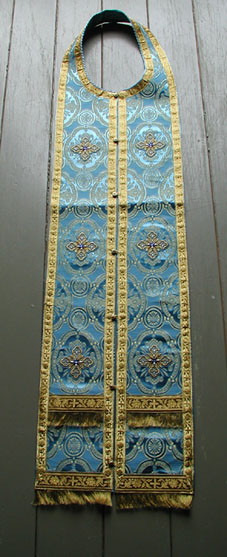Scarf
Scarf refers to a piece of fabric worn around the neck, head, or waist for warmth, sun protection, cleanliness, fashion, or religious reasons. Scarves can be made from a variety of materials including wool, cotton, silk, and synthetic fibers. The design of scarves can vary widely, from simple solid colors to complex patterns, and they can be knit, woven, or made using a variety of textile production techniques.
History[edit | edit source]
The history of the scarf can be traced back to ancient Rome, where it was used not for warmth but to keep clean. Known as a sudarium (Latin for "sweat cloth"), it was used to wipe the face's sweat. This practice was adopted by men around their necks or tied to their belts. Scarves have also been a part of military uniforms, where they were used for identification and as a sign of rank, starting from the Chinese military in the Qin Dynasty to modern times.
In the 19th century, scarves became a fashion accessory for both men and women, popularized in part by the French. With the advent of mass-produced textiles, scarves became more accessible to the general public, leading to a diversification in the types and styles of scarves available.
Types of Scarves[edit | edit source]
There are several types of scarves, each serving different purposes and suited to different styles and needs:
- Headscarf: Worn around the head, often for religious or cultural reasons, but also for fashion or protection against the elements.
- Neck scarf: The most common type, worn around the neck for warmth or as a fashion accessory.
- Shawl: A larger piece of fabric that can be wrapped around the body or shoulders, often used for warmth or as a formal wear accessory.
- Bandana: A square piece of fabric, traditionally worn around the neck or head, often associated with certain cultural or work-related identities.
Materials[edit | edit source]
Scarves are made from a wide range of materials, each offering different qualities:
- Wool: Provides warmth and is often used for winter scarves.
- Silk: Known for its smooth texture and sheen, silk scarves are popular as fashion accessories.
- Cotton: Breathable and easy to wash, cotton scarves are suitable for warmer weather.
- Synthetic fibers: Such as polyester, are durable and often more affordable than natural fibers.
Fashion and Style[edit | edit source]
Scarves have long been a staple in fashion, offering both function and a statement piece for outfits. They can be styled in numerous ways, from simple loops around the neck to intricate knots and drapes. Designers often incorporate scarves into their collections, using them to add color, texture, or a unique touch to ensembles.
Cultural Significance[edit | edit source]
In many cultures, scarves carry significant meanings or are part of traditional attire. For example, in some Middle Eastern countries, the keffiyeh is worn as a symbol of cultural identity. In other cultures, scarves are worn as part of religious observance, such as the hijab in Islam.
Care and Maintenance[edit | edit source]
The care of a scarf depends on its material. Wool and silk scarves require gentle handling, often needing hand washing or dry cleaning, while cotton and synthetic scarves are more resilient and can be machine washed.
Search WikiMD
Ad.Tired of being Overweight? Try W8MD's physician weight loss program.
Semaglutide (Ozempic / Wegovy and Tirzepatide (Mounjaro / Zepbound) available.
Advertise on WikiMD
|
WikiMD's Wellness Encyclopedia |
| Let Food Be Thy Medicine Medicine Thy Food - Hippocrates |
Translate this page: - East Asian
中文,
日本,
한국어,
South Asian
हिन्दी,
தமிழ்,
తెలుగు,
Urdu,
ಕನ್ನಡ,
Southeast Asian
Indonesian,
Vietnamese,
Thai,
မြန်မာဘာသာ,
বাংলা
European
español,
Deutsch,
français,
Greek,
português do Brasil,
polski,
română,
русский,
Nederlands,
norsk,
svenska,
suomi,
Italian
Middle Eastern & African
عربى,
Turkish,
Persian,
Hebrew,
Afrikaans,
isiZulu,
Kiswahili,
Other
Bulgarian,
Hungarian,
Czech,
Swedish,
മലയാളം,
मराठी,
ਪੰਜਾਬੀ,
ગુજરાતી,
Portuguese,
Ukrainian
Medical Disclaimer: WikiMD is not a substitute for professional medical advice. The information on WikiMD is provided as an information resource only, may be incorrect, outdated or misleading, and is not to be used or relied on for any diagnostic or treatment purposes. Please consult your health care provider before making any healthcare decisions or for guidance about a specific medical condition. WikiMD expressly disclaims responsibility, and shall have no liability, for any damages, loss, injury, or liability whatsoever suffered as a result of your reliance on the information contained in this site. By visiting this site you agree to the foregoing terms and conditions, which may from time to time be changed or supplemented by WikiMD. If you do not agree to the foregoing terms and conditions, you should not enter or use this site. See full disclaimer.
Credits:Most images are courtesy of Wikimedia commons, and templates, categories Wikipedia, licensed under CC BY SA or similar.
Contributors: Prab R. Tumpati, MD






